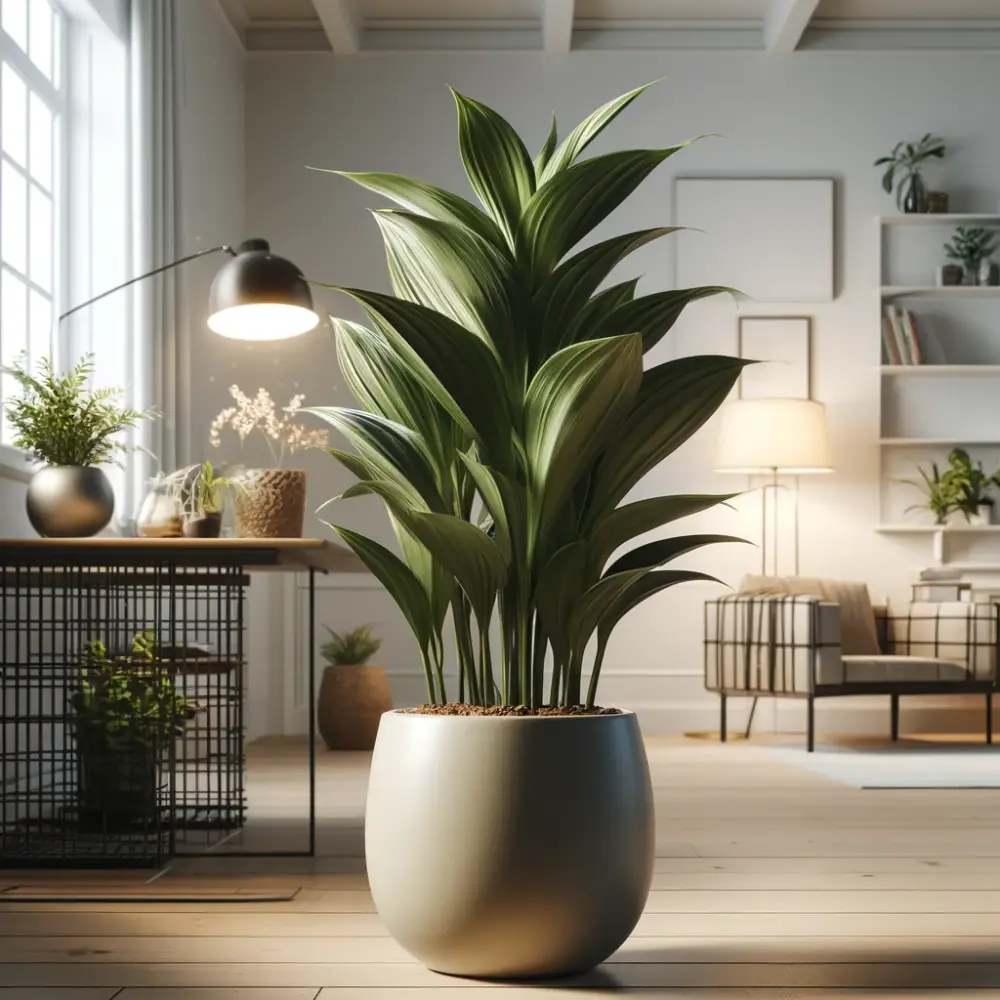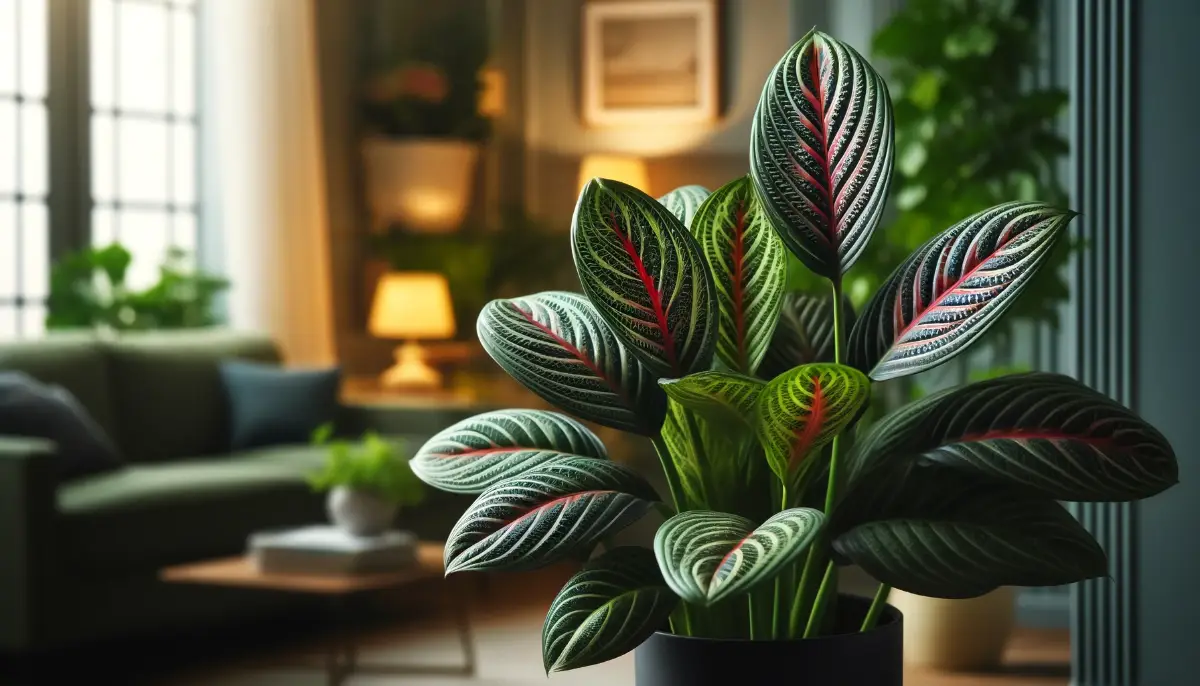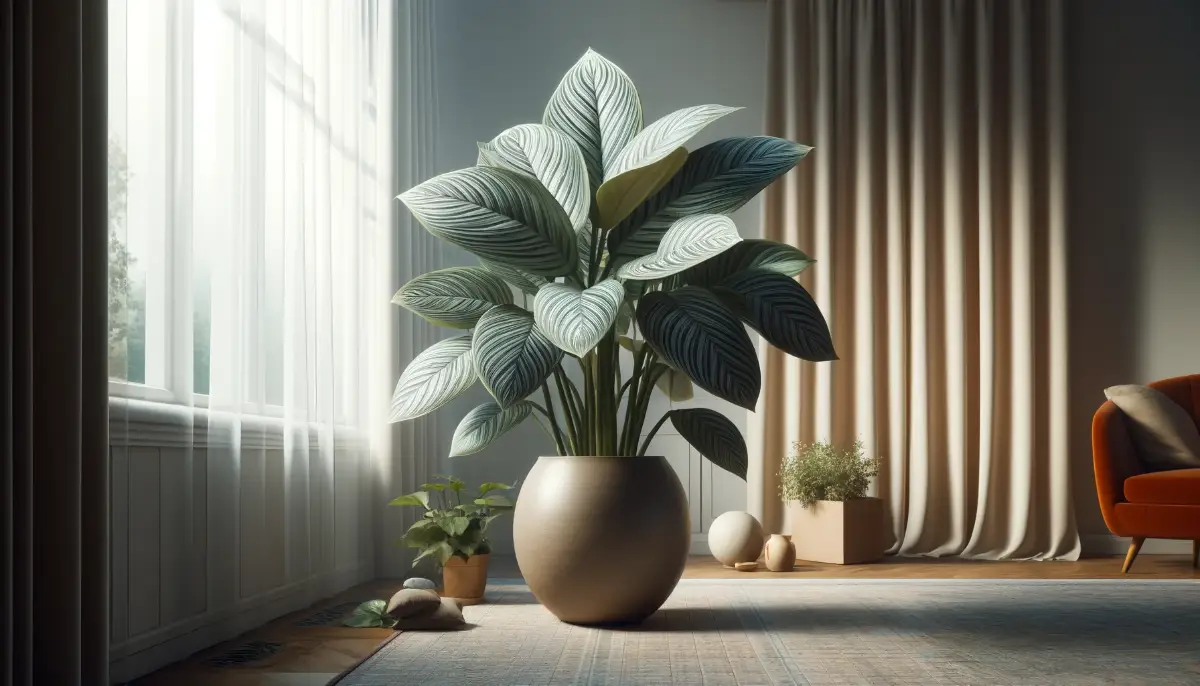Aspidistra elatior, better known as the Cast Iron Plant, has long been celebrated for its resilience and low-maintenance requirements, making it a popular choice for both novice and experienced gardeners.
Native to the understory forests of East Asia, particularly Japan and Taiwan, this perennial is prized for its ability to thrive in conditions that would be challenging for many other plants.
With its lush, dark green leaves that can grow up to 24 inches long, the Cast Iron Plant adds a touch of simplistic elegance to any indoor space.
The name “Cast Iron Plant” speaks to its robust nature, as it is capable of surviving minimal light, low humidity, temperature fluctuations, and infrequent watering. This makes Aspidistra elatior particularly suited for indoor environments where other plants might struggle.
In addition to its durability, the plant is also known for its air-purifying qualities, which contribute to a healthier living environment.
Optimal Growing Conditions for Aspidistra elatior (Cast Iron Plant)
To ensure your Cast Iron Plant thrives, it’s important to create an environment that mimics its natural habitat. Here are the key factors to consider when establishing the optimal growing conditions for Aspidistra elatior:
Light Requirements
- Indirect Light: The Cast Iron Plant flourishes in low to moderate indirect light, making it ideal for areas in your home that don’t receive abundant sunlight. Place it in a location where sunlight is filtered through curtains or blinds.
- Avoid Direct Sunlight: Direct sunlight can scorch the leaves of Aspidistra elatior, causing them to fade and lose their vibrant green color. If only a sunny spot is available, use a sheer curtain to diffuse the light.
Temperature and Humidity
- Temperature: Aspidistra elatior prefers consistent temperatures between 50-75°F (10-24°C). It can tolerate fluctuating temperatures but should be protected from drafts and extreme cold.
- Humidity: While it can tolerate low humidity, the plant thrives in moderate humidity environments. If your home is dry, especially during winter months, consider using a humidifier or placing a water tray near the heating source to increase moisture in the air.
Soil and Watering
- Soil: The Cast Iron Plant prefers well-drained soil rich in organic matter. A good potting mix would be one part garden soil, one part peat moss, and one part perlite or sand to ensure proper drainage.
- Watering: Water the plant deeply but infrequently, allowing the soil to dry out slightly between waterings. Over-watering can lead to root rot, so it’s crucial to ensure the pot has adequate drainage.
These conditions provide a foundation for your Cast Iron Plant to not only survive but to grow robustly, enhancing its ability to purify the air and add aesthetic value to your home.
Soil and Planting for Aspidistra elatior (Cast Iron Plant)
To promote healthy growth and longevity of your Cast Iron Plant, proper soil composition and planting techniques are essential. Here are some detailed guidelines:
Soil Composition
- Ideal Soil Mix: Aspidistra elatior thrives in a well-draining, rich organic soil mix. A recommended mixture would consist of one part garden soil, one part peat moss or coco coir to retain moisture, and one part perlite or coarse sand to improve drainage.
- pH Level: The Cast Iron Plant prefers a slightly acidic to neutral pH, ranging from 5.5 to 6.5. This pH level helps the plant absorb nutrients efficiently.
Potting and Repotting
- Choosing the Right Pot: Opt for a pot that has good drainage holes. Material-wise, terracotta pots are ideal because they allow the soil to dry more evenly, but plastic or ceramic pots are also suitable if they provide adequate drainage.
- When to Repot: Repotting is generally needed every 2-3 years or when the plant outgrows its current pot. Signs that indicate the need for repotting include roots growing through the drainage holes, slowed growth, or soil that dries out too quickly.
Repotting Steps:
Choose a Slightly Larger Pot: Select a new pot that is one size larger than the current one. This gives the roots room to grow without providing too much space, which could lead to water logging.
Prepare the New Pot: Place a layer of potting mix in the bottom of the pot.
Remove the Plant: Carefully take the plant out of its current pot, gently shaking off excess soil and inspecting the roots. Trim any rotted or excessively long roots.
Replant: Position the plant in the new pot and fill around the roots with fresh potting mix. Gently firm the soil to eliminate air pockets and water thoroughly to settle the soil.
Additional Tips
- Avoid Over-Potting: Too large a pot can hold excess moisture, leading to root rot. It’s better to pot conservatively.
- Top Dressing: Annually replace the top few inches of soil with fresh potting mix to replenish nutrients and improve soil structure, especially if you’re not repotting.
Watering and Organic Feeding for Aspidistra elatior (Cast Iron Plant)
Proper watering and feeding are critical to maintaining the health and vigor of your Cast Iron Plant. Here’s how to effectively manage these aspects using organic methods:
Watering Schedule
- Frequency of Watering: Aspidistra elatior requires less water than many other houseplants due to its tolerance for dry conditions. Water the plant when the top inch of soil feels dry to the touch. This typically means watering approximately every 1-2 weeks, depending on the humidity and temperature of your environment.
- Method of Watering: Water thoroughly, allowing water to run out of the drainage holes. This ensures the roots at the bottom receive moisture. Always empty the saucer under the pot to prevent standing water, which can cause root rot.
- Adjustments for Seasons: Reduce watering in the winter when plant growth naturally slows down and increase it slightly during the growing season (spring and summer).
Organic Feeding
- Type of Fertilizer: Opt for an organic, balanced fertilizer such as a seaweed-based or fish emulsion product. These fertilizers not only supply essential nutrients but also support soil health.
- Feeding Frequency: Fertilize your Cast Iron Plant every 1-2 months during the growing season and reduce to once every 3-4 months during the dormant winter months. Over-fertilizing can harm the plant, leading to salt buildup that can burn the roots and damage the foliage.
- Application Method: Dilute the organic fertilizer according to the product instructions. Apply it after watering the plant to prevent root burn and to ensure even distribution of nutrients.
Additional Organic Care Tips
Composting: Adding a top layer of compost can be beneficial for the Cast Iron Plant. Compost provides a slow-release source of nutrients, which is ideal for this low-feeding plant. Apply a thin layer of compost around the plant once a year, preferably in the spring.
Mulching: Use organic mulch like cocoa hulls or bark around the base of the plant to help retain soil moisture and add organic matter as it decomposes.
Pruning and Maintenance for Aspidistra elatior (Cast Iron Plant)
Proper pruning and regular maintenance are key to keeping your Cast Iron Plant looking its best and promoting healthy growth. Here’s how to manage these aspects effectively:
Pruning
- When to Prune: Pruning is generally minimal with Aspidistra elatior, as the plant grows slowly and maintains a neat appearance. However, occasional pruning may be necessary to remove dead or yellowing leaves and to shape the plant.
- How to Prune: Use clean, sharp scissors or pruning shears. Cut the unwanted leaves off at the base, near the soil line. This helps prevent damage to the remaining healthy parts of the plant and keeps the appearance tidy.
Cleaning
- Dusting the Leaves: The broad leaves of the Cast Iron Plant can accumulate dust, which can inhibit their ability to absorb light and perform photosynthesis. Gently wipe the leaves with a damp cloth every few weeks to remove dust.
- Using Neem Oil: If pests are a concern, neem oil can be an effective organic option for treating issues like spider mites or scale. Apply a diluted solution of neem oil to the leaves, following product guidelines for concentration levels and application frequency.
General Maintenance Tips
- Inspect Regularly: Regular inspection helps catch any potential issues early, such as signs of pests or disease. Look for discolored leaves, sticky residues, or other abnormalities.
- Environmental Adjustments: Ensure that your Cast Iron Plant is in an ideal location where it receives appropriate light and is not exposed to drafts or sudden temperature changes. Adjust its position as needed depending on seasonal changes in light exposure and indoor heating/cooling.
- Soil Check: Occasionally check the soil for proper moisture and drainage. Ensure that the pot allows for adequate drainage to prevent waterlogging. Top dress with fresh soil annually to replenish nutrients and improve soil structure.
Long-Term Care
- Repotting: While repotting is not frequently necessary, doing it every 2-3 years can refresh the environment of your Cast Iron Plant. This is a good opportunity to inspect the root system for health, prune any rotted roots, and provide new soil for continued growth.
- Seasonal Adjustments: Adjust care routines with the seasons—less water and fertilizer in the winter, more in the growth season of spring and summer.
Propagation of Aspidistra elatior (Cast Iron Plant)
Propagating the Cast Iron Plant is a straightforward process that allows you to create new plants from an established one. The most effective method for Aspidistra elatior is division. Here’s a detailed guide on how to propagate this durable houseplant:
Preparation for Division
- Best Time to Divide: Spring is the ideal time for dividing Cast Iron Plants, as this gives the new plants plenty of time to establish themselves during the growing season.
- Tools Required: You’ll need a sharp knife or pruning shears, and pots filled with suitable potting mix. Ensure all tools are clean to avoid introducing diseases.
Steps for Propagation by Division
- Remove the Plant from Its Pot: Carefully take the entire plant out of its pot. You might need to tap the sides of the pot or gently pull the plant out by the base of its stems if it’s tightly packed.
- Clean Off Excess Soil: Shake off excess soil from the roots so you can clearly see the divisions and root structure.
- Identify Division Points: Look for natural separations between the clumps of leaves and roots. Each division should have several leaves and a healthy segment of roots.
- Separate the Clumps: Using your sharp knife or hands, gently separate the clumps at the natural division points. Make sure each new section has an adequate root system attached.
- Pot Up the Divisions: Plant each division in its own pot filled with a suitable potting mix (a blend of garden soil, peat moss or coco coir, and perlite or sand for drainage). The pot should be appropriately sized for the division, not too large to prevent waterlogging.
- Water Gently: After potting, water each new plant thoroughly to settle the soil around the roots. Ensure proper drainage to avoid soggy soil conditions.
Aftercare for Propagated Plants
- Initial Care: Place the new plants in a location where they will receive indirect light. Avoid direct sunlight which can scorch the leaves. Keep the soil consistently moist but not waterlogged during the first few weeks to help the roots establish.
- Monitor for Growth: Keep an eye on the new plants for signs of growth or distress. Adjust care as necessary, such as increasing humidity around the plant if the edges of the leaves start to brown.
- Long-term Care: Once established, care for the new Cast Iron Plants as you would the parent plant, adjusting watering, lighting, and feeding according to the plant’s needs and environmental conditions.
Pest and Disease Management and Troubleshooting Common Issues for Aspidistra elatior (Cast Iron Plant)
Properly managing pests and diseases and addressing common issues are essential for maintaining the health of your Cast Iron Plant. Here’s a guide on how to identify and treat common problems:
Pest and Disease Management
Common Pests:
- Spider Mites: These tiny pests can cause yellowing and speckling on leaves. To manage spider mites, increase humidity around the plant and wash the leaves with a strong jet of water. Applying neem oil or an insecticidal soap can also be effective.
- Mealybugs: These white, cottony pests tend to gather in leaf axils and on the undersides of leaves. Remove them manually using a cotton swab dipped in alcohol or apply an organic insecticide.
Common Diseases:
- Root Rot: Often caused by overwatering, root rot appears as soft, brown roots and wilting leaves. To address this, reduce watering, improve drainage, and, if severe, repot the plant into fresh soil after cutting away any rotted roots.
- Leaf Spot: Fungal or bacterial leaf spot can cause brown or black spots on leaves. Improve air circulation around the plant and reduce leaf wetness to manage these conditions. In severe cases, remove affected leaves and treat the plant with a fungicidal spray.
Troubleshooting Common Issues
Yellow Leaves:
- Cause: Overwatering is a common cause, but nutrient deficiencies or root rot could also be factors.
- Solution: Check the moisture level of the soil and adjust your watering schedule accordingly. If the problem persists, inspect the roots for rot and consider repotting with fresh soil.
Brown Leaf Tips:
- Cause: Low humidity, over-fertilization, or fluoride in water can lead to brown tips.
- Solution: Increase humidity around the plant, reduce fertilizer use, and water with non-fluoridated water (such as rainwater or distilled water).
Slow Growth or No Growth:
- Cause: Insufficient light, overly cool temperatures, or pot-bound roots.
- Solution: Move the plant to an area with more indirect light, ensure the room temperature is within the ideal range, and check if the plant needs repotting.
Drooping Leaves:
- Cause: Underwatering or overwatering can both cause leaves to droop.
- Solution: Check the soil moisture and adjust your watering practices. Ensure the pot has good drainage to prevent waterlogging.
FAQs about Aspidistra elatior (Cast Iron Plant)
How often should I water my Cast Iron Plant?
Water your Cast Iron Plant when the top inch of soil feels dry, typically every 1-2 weeks. Adjust the frequency based on the humidity and temperature of your environment, watering less often in winter.
Does the Cast Iron Plant need natural sunlight?
The Cast Iron Plant thrives in low to moderate indirect light and can tolerate low light conditions well. It should be kept out of direct sunlight, which can scorch its leaves.
How do I know if I am overwatering my plant?
Signs of overwatering include yellowing leaves, a mushy base, and a general limp appearance. If the soil feels soggy or smells musty, you might be overwatering.
What is the best soil for a Cast Iron Plant?
Use a well-draining, rich organic soil mix, ideally composed of one part garden soil, one part peat moss or coco coir, and one part perlite or coarse sand.
Can I use tap water to water my Cast Iron Plant?
Yes, you can use tap water, but if your tap water is heavily fluoridated or contains high levels of chlorine, it’s better to use distilled or non-fluoridated water to avoid brown tips on the leaves.
How do I propagate a Cast Iron Plant?
Propagate by division. Separate a section of the plant that includes roots and several leaves. Plant it in similar soil conditions and care for it as you would the main plant.
What are the common pests that affect Cast Iron Plants?
Common pests include spider mites and mealybugs. Treat infestations with neem oil or insecticidal soap and increase humidity around the plant to deter spider mites.
How frequently should I fertilize my Cast Iron Plant?
Fertilize with an organic balanced fertilizer every 1-2 months during the growing season (spring and summer) and reduce to once every 3-4 months during the dormant winter months.
When should I repot my Cast Iron Plant?
Repot every 2-3 years or when the plant shows signs of being root-bound, such as roots growing through the drainage holes or the soil drying out too quickly.
Why are the leaves of my Cast Iron Plant turning yellow?
Yellow leaves can be caused by overwatering, underwatering, or nutrient deficiencies. Check the soil’s moisture level and adjust your watering schedule accordingly. If the problem persists, consider repotting with fresh soil or adjusting your fertilization routine.









